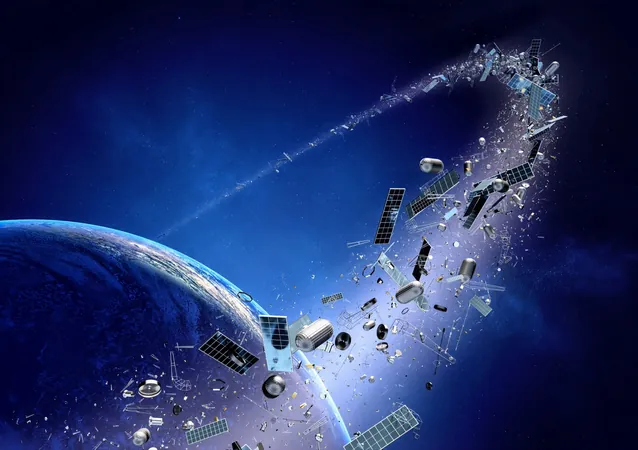
Earth's Space Debris Crisis: A Threat to Communication and Space Missions!
2024-12-31
Author: Wei
Earth's Space Debris Crisis: A Threat to Communication and Space Missions!
On October 19, a shocking announcement from the US Space Command detailed a significant incident: the Intelsat 33e satellite disintegrated into approximately 20 pieces, exacerbating the already pressing issue of space debris in Low Earth Orbit (LEO). The cause of this alarming fragmentation remains under investigation, yet the event has reignited urgent discussions about the growing peril of space junk threatening not only satellite operations but also the very fabric of our modern digital life.
Understanding Low Earth Orbit (LEO)
Low Earth Orbit (LEO) is defined as a region extending from roughly 100 to 1,200 miles (160 to 2,000 kilometers) above the Earth's surface. This orbit is favored for its cost-effectiveness and efficiency, allowing satellites to complete an orbit in approximately 90 minutes. Major endeavors, including the International Space Station (ISS), weather satellites, and communication systems, all rely on LEO due to its optimal conditions for rapid data transmission and lower latency.
But as the number of satellites swells—there are already over 10,000 active satellites orbiting Earth, with around 6,800 belonging to Elon Musk's Starlink—they push the envelope of what's sustainable in space. Upcoming plans from companies like SpaceX and Amazon to launch thousands more only heighten the stakes.
The Dire Threat of Kessler Syndrome
Introduced by NASA scientists Donald Kessler and Burton Cour-Palais in 1978, Kessler Syndrome predicts a catastrophic chain reaction of collisions as objects in orbit collide, generating more debris, which further increases the likelihood of additional crashes. If this spiraling cycle continues unchecked, LEO could become a polluted wasteland, crippling our ability to launch new satellites and operate existing technologies—impacting GPS, the internet, and weather forecasting.
John L. Crassidis, a space debris expert at the University at Buffalo, warns, “If the probability of a collision is so great that we can’t put a satellite in space, then we’re in trouble.”
Consequences and Current Challenges
The implications of space debris are far-reaching. Sustaining operations on the ISS is becoming increasingly dangerous, with astronauts often needing to execute evasive maneuvers to avoid incoming debris. Recent incidents show debris coming alarmingly close to manned missions, with one fragment passing just 2.5 miles from the ISS.
This congestion doesn’t merely threaten astronauts; it can also lead to the failure of essential services that rely on satellites—potentially throwing chaos into the everyday lives of millions who depend on GPS, broadband internet, and satellite TV.
Mitigating the Risks of Kessler Syndrome
In response to the escalating crisis, initiatives are being launched to capture and deorbit defunct satellites. The European Space Agency (ESA) is spearheading projects like Clearsat-1, aimed at reducing the clutter in space. Additionally, innovative technologies, such as drag sails, are being developed to hasten the natural re-entry of debris into Earth’s atmosphere.
Despite these efforts, the current tracking technology faces significant limitations. Over 40,500 pieces of debris larger than 10 centimeters are currently estimated to be in orbit, alongside millions of smaller, untraceable fragments.
A Call for Governance in Space
Experts emphasize the critical need for coordinated global efforts to create enforceable regulations addressing space debris. Initiatives like the United Nations' Pact for the Future aim to establish frameworks for safe space traffic and resource management, yet effective enforcement remains elusive. Dr. Vishnu Reddy, a planetary sciences professor at the University of Arizona, underscores, “The biggest concern is the lack of regulation. Norms and guidelines coming from the industry will be essential.”
Looking Ahead: A Future at Risk
As the density of satellites in Low Earth Orbit mounts, the specter of Kessler Syndrome looms larger. Without proactive measures—ranging from advanced tracking technologies to stringent international regulations—we may face a future where space remains inaccessible for exploration and communication.
The ramifications extend well beyond the realm of scientific discovery; they threaten the very infrastructure of our daily lives, which heavily relies on satellite technology. Immediate action is needed to foster international cooperation and implement robust policies that safeguard the future of our orbital environment.
If we fail to address this mounting crisis together, we could well find ourselves on the precipice of a new dark age, where both adventurers of space and everyday users of technology may suffer dire consequences.
Stay tuned as we continue to follow this critical global issue!

 Brasil (PT)
Brasil (PT)
 Canada (EN)
Canada (EN)
 Chile (ES)
Chile (ES)
 Česko (CS)
Česko (CS)
 대한민국 (KO)
대한민국 (KO)
 España (ES)
España (ES)
 France (FR)
France (FR)
 Hong Kong (EN)
Hong Kong (EN)
 Italia (IT)
Italia (IT)
 日本 (JA)
日本 (JA)
 Magyarország (HU)
Magyarország (HU)
 Norge (NO)
Norge (NO)
 Polska (PL)
Polska (PL)
 Schweiz (DE)
Schweiz (DE)
 Singapore (EN)
Singapore (EN)
 Sverige (SV)
Sverige (SV)
 Suomi (FI)
Suomi (FI)
 Türkiye (TR)
Türkiye (TR)
 الإمارات العربية المتحدة (AR)
الإمارات العربية المتحدة (AR)